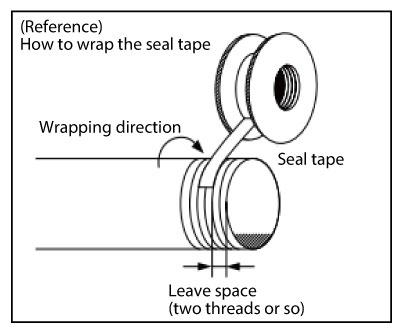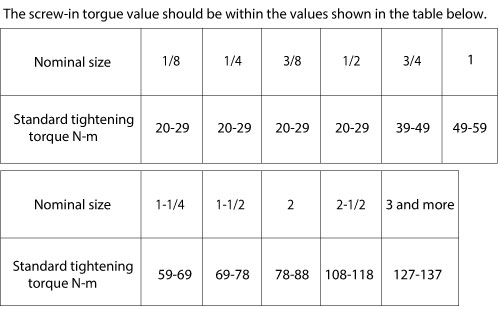Check Valves Questions
External Leakage
- Gate Valves
- Globe Valves
- Check Valves
- Ball Valves
- Fluid leaks from the screwed area.
-
When connecting the valve to the pipe, wrap PTFE seal around the male threads or apply a thin layer of suitable liquid sealant. Do not use a tool and screw the pipe manually to insert it to the deepest position of the valve bore, while carefully checking the feel for the right fit of the threads.
Choose and used an appropriate seal tape suitable to the fluid used, working temperature and other parameters. Make sure that the seal material does not enter inside the valve.
When wrapping the tape, it should be wrapped two or three times in the same direction as the thread-tightening direction.
If the tape is wrapped in the opposite direction, the pipe may be loosened during installation, leading to leakage.
Applicable product
- Gate Valves
- Globe Valves
- Check Valves
- Ball Valves
- The valve body was cracked, causing external leakage.
-
When the residual water in the pipe or valve is frozen, the product may be damaged and external leakage may occur.
In an environment where freezing is expected, remove the residual water from the pipe or implement the appropriate anti-freezing measures, such as thermal insulation or heater, to the valve and pipeline.
Applicable product
Internal Leakage
- Gate Valves
- Globe Valves
- Check Valves
- Ball Valves
- Although the valve is fully closed, the seat still leaks.
-
① Foreign particles may be caught on the seat surface.
After the installation of the valve, the inside of the pipeline should be flushed with the valve fully opened to remove the foreign particles.② If the valve and the pipe are made of different metals, a cell may be formed because of the potential difference between the metals. This may cause galvanic corrosion inside the valve, leading to the possibility that the handle gets stuck or seat leakage occurs. Use the same material for the valve and the pipes when they are used in the same pipeline.
Applicable product
Improper Piping
- Gate Valves
- Globe Valves
- Check Valves
- Ball Valves
- The valve cannot be screwed into the piping.
-
① The pipe threads may be deformed.
The threads may be deformed when the valve is attached to the pipes with a pipe wrench or vice. Use an appropriate tool, such as a spanner, to retighten the valve with the proper tightening torque.
When installing the valve to the pipe, apply an appropriate tool to the pipe connection area of the valve body. Place the tool to the area near the side attached to the pipe.② Check that the pipe is not inserted obliquely.
Confirm that the pipe threads are machined in accordance with the thread standards that meet the product used..


Applicable product
Abnormal Noise
- Check Valves
- Abnormal noise (chattering phenomenon) occurs.
-
If the flow is not constant, varies in speed or generates turbulence, pulsation, etc., the disc may come into contact with the valve disc, body or seat surface, causing abnormal noise (chattering).
Contact us for appropriate flow rate conditions.
Applicable product
Oil Leakage
- Gate Valves
- Globe Valves
- Check Valves
- Ball Valves
- Butterfly Valves
- When I tried to install the valve, oil came out.
-
For our standard products, oil and grease are applied for the purposes of lubrication and rust prevention.
Contact us in case oil-free products are required.
Applicable product
